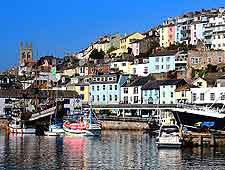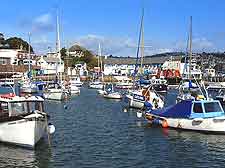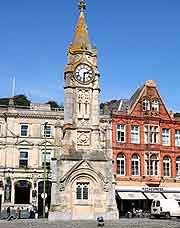Torbay History Facts and Timeline
(Torbay, Devon, England)

The history of Torbay spans many centuries. The earliest traces of settlement around this natural harbour are thought to date back to Paleolithic times. There's also evidence that Roman soldiers visited Kent's Cavern.
Torbay's name originally derives from the word 'tor', which is Saxon for craggy hill or peak. The bay, which has become known as the English Riviera, is made up of the towns of Torquay, Paignton and Brixham.

Torbay's Early History
Torquay grew up around the Saxon hamlet of Torre. In 1196, a community of monks founded Torre Abbey. They went on to build a quay here.
For centuries, Torquay's economy was based predominantly on fishing and agriculture. Paignton is thought to have grown up around 700 AD. It appears in the Domesday Book of 1086 and, in 1294, was granted the right to hold a market and fair. Brixham also appears in the Domesday book. It actually started out life as two towns - Higher Brixham was mainly rural, whilst Lower Brixham was a fishing port.
Until the early 19th century, the most notable event in Torbay's history appears to have been the arrival of the future King William III in Brixham in 1688, during the Glorious Revolution.

A Victorian Seaside Resort
During the early 19th century, Torbay became popular with fashionable and well-heeled Victorian visitors. This was partly because of the Napoleonic Wars, which put a temporary stop to continental holidays. The war also brought naval officers and their wives to Torbay. In July 1815, following his defeat at the Battle of Waterloo, Napoleon Bonaparte was taken prisoner and brought to Torbay. Awaiting his journey into exile, the French Emperor could be seen pacing the deck of his prison ship in full uniform. Needless to say, he became an instant tourist attraction.
It was a local solicitor and banker, William Kitson, though, who was to transform Torbay even further. He helped to develop an exclusive residential area in Torquay's Warberries and Lincombes. Elegant villas were built, including Hesketh Crescent with its sweeping Regency facade. In Paignton, an opulent mansion was built for Isaac Singer of sewing machine fame. However, tourism appears to have had little impact on Brixham, which remained associated with fishing and trawling.
In 1848, the South Devon railway arrived in Torbay, making it even easier for visitors to travel here. Torquay's Torre Railway Station opened that year and the rail line was extended to include Paignton in 1859 and Brixham in 1861. In 1892, Torquay was granted a Royal Charter. It also became known as the Queen of the Watering Places, adopting the Latin motto of 'Salus et Felicitas', meaning 'Health and Happiness'.
20th Century Torbay
During the 1948 Olympics, Torbay hosted the yachting events, with Torre Abbey serving as the venue for the opening and closing ceremonies. During the 1960s and 1970s, Torbay became the venue for some scenes from Monty Python's Flying Circus, which were filmed in both Torquay and Paignton. Torbay became a unitary authority in 1998.
 The history of Torbay spans many centuries. The earliest traces of settlement around this natural harbour are thought to date back to Paleolithic times. There's also evidence that Roman soldiers visited Kent's Cavern.
The history of Torbay spans many centuries. The earliest traces of settlement around this natural harbour are thought to date back to Paleolithic times. There's also evidence that Roman soldiers visited Kent's Cavern.
